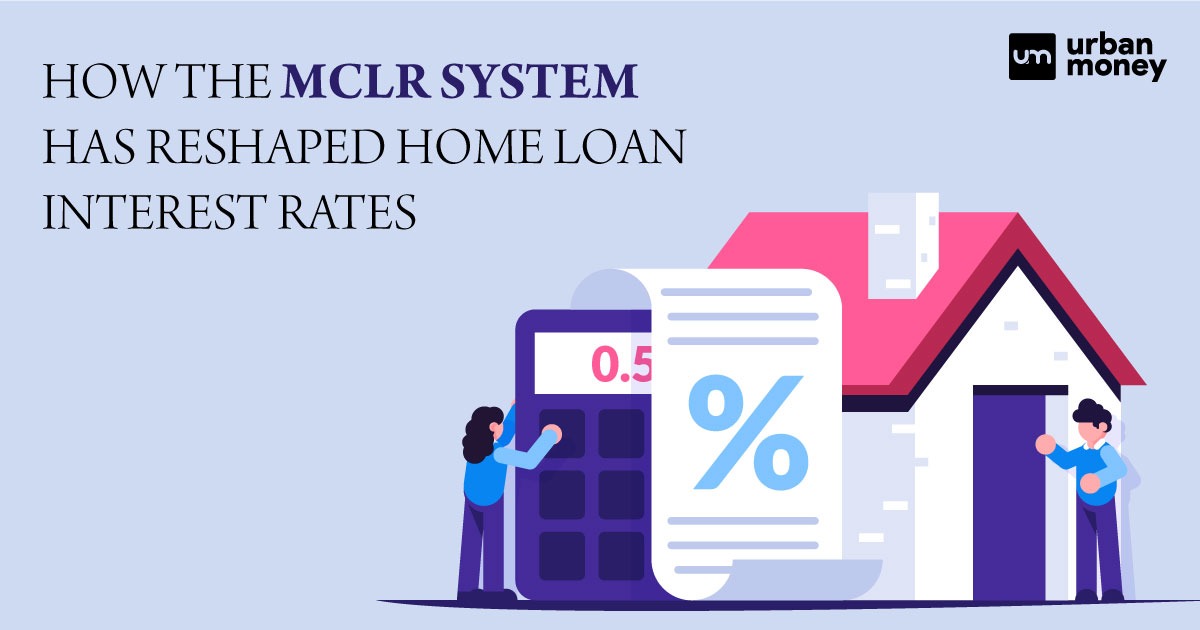Top 10 Best Private Banks in India List 2025
January 09, 2025
Home Loan Archive | MCLR – Marginal Cost of Funds Based Lending Rate

October 18, 2022


MCLR stands for Marginal Cost of Funds Based Lending Rate. It is an internal benchmark or a reference rate that a financial institution is expected to adhere to. It determines the lower end of home loan rates of interest. Banks are prohibited from lending money to borrowers with interest lower than a particular amount, except under certain special circumstances.
The Reserve Bank of India introduced this method in 2016 to tackle anything related to the existing base interest rate regime. It offered borrowers taking up different kinds of loans the opportunity to benefit from the rate cuts introduced by the RBI. The RBI breathed life into MCLR primarily to replace the base rate system in place to monitor the minimum interest rate for home loans back in 2010. This system aims to prevent banks from granting their prime customers certain undue advantages regarding repayment schemes and interests.
For instance, if a bank’s base interest rate were at 7%, they would lend money to their prime patrons at an interest rate of 7% or lower. However, this would put an undue burden on their regular customers, potentially pushing their interest rates up to 10-12%.
Since base rates were considered a bank’s internal policy, it would often result in substantial financial losses.
Furthermore, banks would take little time to adjust and update their interest rates even after rate cuts. With the introduction of the marginal cost of funds-based lending rates, banks and lenders have been forced to function with a higher degree of transparency when determining interest rates for home loans. The system also requires banks to offer borrowers the benefits that come with lower interest rates. It has also leveled the playing field between a borrower and lender, making the process fair for all parties involved.
Borrowers who availed loans from financial institutions and/or lenders before April 1, 2016, must pay the interest by the existing base rate system. The marginal cost of the funds-based lending rate is significantly lower than the base rate system. The difference between the two systems could come to anywhere between 5 to 50 basis points. The significant difference in the rates is prompted by the MCLR’s close link with the repo rate. It results in the more efficient transmission of the Reserve Bank of India’s rate cut to the individual who borrowed money from a lender or bank. However, borrowers who availed of loans before April 1, 2016, still have the luxury of shifting loans to the MCLR system and enjoy the top-most banks’ rate cuts.
To comply with the rules requiring this added level of transparency, banks and lenders must release exact details about their 3-year-, 2-year, 1-year, 6-month, 3-month, 1-month, and overnight interest rates regularly. As a borrower, one can access information regarding the same on a particular institution’s official website.
Table of Contents
ToggleMCLR is calculated based on the loan’s tenor, which means the duration the borrower takes to repay the loan affects the interest rate. This internal process is subjective to the bank a borrower approaches to apply for a loan. In addition to the tenure of the loan, several factors affect this system:
This refers to the charge that the bank levies to account for the risks involved with offering borrowers a loan with a longer tenor. The risk involved with loans is directly proportional to the length of the tenor. Banks charge borrowers a premium to cover the risk that they run.
As the name suggests, operating costs are all the charges the bank has to cover to provide financial aid to borrowers. Operating costs include the bank’s charges while raising funds, opening new branches, paying salaries to the employees working there, and more. However, the service of offering financial aid to borrowers itself is a separate cost that the bank exacts from its patrons with separate service charges.
Cash Reserve Ratio or CRR is a portion of the bank’s financial haul that banks must submit to the RBI as liquid cash. The banks are prohibited from monetizing this amount, which means they cannot earn any money using this reserve and cannot charge interest on it. Therefore, this reserve is accounted for negatively. Per the regulations of the MCLR system, banks are offered certain allowances on the CRR, called Negative Carry on CRR. Banks calculate this amount as described below: – Required CRR × [marginal cost ÷ (1 – CRR)]
Banks calculate the Marginal Cost of Funds by tallying up everything the bank has borrowed. Banks borrow funds from different sources, including savings accounts, current accounts, fixed deposits, RBI loans, etc. MCF is calculated by using the interest rates of the bank’s loans. MCF consists of ‘Return on Net Worth’ and ‘Marginal Cost of Borrowing’. The former takes up 8%, and the latter takes 92%. This 8% is equivalent to banks’ risk of weighted assets per Tier 1 capital.
Banks are required to update their MCLR rates every month. The banks make these changes per the revisions introduced by the RBI, the repo rate and the other rates related to borrowing. When the RBI hikes the repo rate, it kicks off a ripple effect that boosts the cost of borrowing for banks, and borrowers bear the brunt of this hike as they are slapped with a higher interest rate on their loans.
The RBI is responsible for taking all decisions related to the monetary policy of the Indian Rupee. The policy repo rate went up from 4.00% to 4.40 on May 4, 2022, which marked an increase of 40 basis points (bps). However, the rate was hiked from 4.40 to% to 4.90% on June 8, 2022, which was an increase of 50 bps. This change left a massive impact on the financial market in the country, as the RBI proposed the last change back in August 2018.
The base rate and marginal cost of funds-based lending rates are based on the same principles. However, borrowers can discern a few minuscule differences between the two:
Converting a base rate home loan to an MCLR home loan is an extremely trouble-free process that banks have refined for the convenience of their customers:
Banks have the liberty to offer all available loan categories at either fixed or fluctuating rates. However, they are expected to adhere to strict deadlines are particular guidelines while disclosing the MCLR or the internal benchmark. They can vary from overnight MCLR to three months, one year, or any other maturity window decided by the bank.
The table below pertains to the rates offered by various banks
| Bank | 3 Years | 2 Years | 1 Year | 6 Months | 3 Months | 1 Months | Overnight |
| SBI | 7.30% | 7.20% | 7.00% | 6.95% | 6.65% | 6.65% | 6.65% |
| HDFC | 7.40% | 7.30% | 7.20% | 7.05% | 6.95% | 6.90% | 6.85% |
| Axis | 7.55% | 7.50% | 7.40% | 7.35% | 7.30% | 7.20% | 7.20% |
| PNB | 7.60% | NA | 7.30% | 7.00% | 6.80% | 6.70% | 6.65% |
| Citibank | NA | NA | 6.30% | 6.15% | 5.95% | 5.90% | 5.70% |
| Induslnd | 8.95% | 8.90% | 8.60% | 8.50% | 8.35% | 8.30% | 8.25% |
| Federal Bank | NA | NA | 7.90% | 7.85% | 7.80% | 7.75% | 7.65% |
| Standard Chartered | 7.60% | 7.25% | 6.65% | 6.50% | 6.50% | 6.40% | 6.15% |
| Canara | NA | NA | 7.35% | 7.30% | 6.95% | 6.70% | 6.70% |
| IDFC First Bank | 9.20% | 8.80% | 8.40% | 8.30% | 8.10% | 8.05% | 8.05% |
| Bank of India | 7.80% | NA | 7.35% | 7.30% | 7.25% | 7.20% | 6.70% |
| Nainital Bank | 8.10% | 7.70% | 7.40% | 7.25% | 7.15% | 7.10% | 7.10% |
| Jammu and Kashmir Bank | 7.85% | 7.80% | 7.35% | 7.20% | 6.90% | 6.70% | 6.60% |
| Central Bank of India | NA | NA | 7.10% | 7.00% | 6.85% | 6.55% | 6.55% |
| Bandhan Bank | 10.86% | 10.33% | 8.94% | 8.46% | 8.27% | 8.15% | 8.08% |
| IDBI Bank | 8.60% | 8.15% | 7.80% | 7.45% | 7.30% | 7.25% | 7.05% |
| UCO Bank | NA | NA | 7.30% | 7.20% | 6.95% | 6.85% | 6.70% |
| Punjab and Sind Bank | NA | NA | 7.65% | 7.55% | 7.45% | 7.30% | 7.15% |
| Bank of Baroda | NA | NA | 7.40% | 7.25% | 7.15% | 7.00% | 6.55% |
The RBI introduced the system of MCLR for the convenience of borrowers across the country. It is meant to hold banks more accountable for their actions and offer borrowers some much-needed insight into the rates at which they are expected to return the money they borrow from banks. Banks previously operated behind a veil of mystery and intrigue; however, the RBI has lifted this veil by doing away with the base rate system and introducing the MCLR system.
| Related Resource |
| Home Loans For Women |
| Plot Loans for Land Purchase |
| Top Housing Finance Companies in India |
| Home Buying Tips |
| Top Home Loans |










© 2025 www.urbanmoney.com. All rights reserved.

Need Loan Assistance?

















